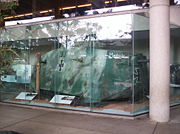.gif)
Mephisto (tank)
Encyclopedia

German Empire
The German Empire refers to Germany during the "Second Reich" period from the unification of Germany and proclamation of Wilhelm I as German Emperor on 18 January 1871, to 1918, when it became a federal republic after defeat in World War I and the abdication of the Emperor, Wilhelm II.The German...
tank
Tank
A tank is a tracked, armoured fighting vehicle designed for front-line combat which combines operational mobility, tactical offensive, and defensive capabilities...
captured by Australian troops during World War I
World War I
World War I , which was predominantly called the World War or the Great War from its occurrence until 1939, and the First World War or World War I thereafter, was a major war centred in Europe that began on 28 July 1914 and lasted until 11 November 1918...
. One of only 21 built, it is the last surviving example of the first German military tank, the A7V
A7V
The A7V was a tank introduced by Germany in 1918, near the end of World War I. One hundred vehicles were ordered during the spring of 1918, but only 21 were delivered. It was nicknamed "The Moving Fortress" by the British because of the shape of the hull...
Sturmpanzerwagen, and is displayed at the Queensland Museum
Queensland Museum
The Queensland Museum is the state museum of Queensland. The museum currently operates four separate campuses; at South Brisbane, Ipswich, Toowoomba and Townsville.The museum is funded by the State Government of Queensland.-History:...
in Australia.
Mephisto, chassis serial number 506, does not appear to be functional, but some years ago was able to be explored. It is now protected from the public and the elements by glass.
The name "Mephisto
Mephistopheles
Mephistopheles is a demon featured in German folklore...
" is painted on the end facing of the box-shaped tank. The tank was captured at the Second Battle of Villers-Bretonneux
Second Battle of Villers-Bretonneux
The Second Battle of Villers-Bretonneux came during the period of the battle of Lys, 24–27 April 1918, but was launched against the British lines in front of Amiens.The Germans developed a small number of tanks, and used them in this offensive...
on 24 April 1918 by the 26th Battalion of the 7th Brigade, mostly from Queensland.
Unlike modern tanks, the A7V has no single, large central turret, but instead is armed with a number of smaller casemate
Casemate
A casemate, sometimes rendered casement, is a fortified gun emplacement or armored structure from which guns are fired. originally a vaulted chamber in a fortress.-Origin of the term:...
s, two on each side and one at each end. A replica A7V was built in Germany in 1991, which is modelled substantially upon Mephisto.
Following the 2011 Brisbane Floods, the Mephisto was removed from the Queensland Museum for restoration work. It is unknown where and when it will be displayed again.
External links
- A7V Mephisto by Greg Czechura and Jeff Hopkins-Weise, ISBN 9780980569209

